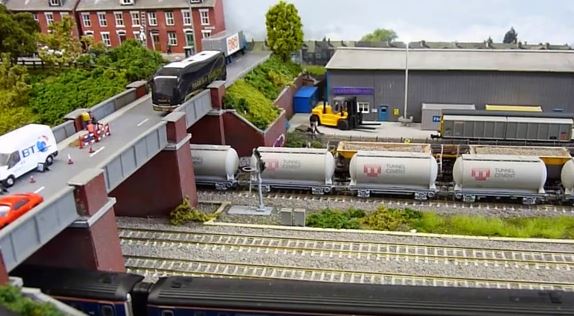Everything on model trains, model railroads, model railways, locomotives, model train layouts, scenery, wiring, DCC and more. Enjoy the world's best hobby... model railroading!
Sealing and Painting Benchwork
Bryan asks readers:
“This is my first layout – HO – I’m working on so I want to try and get most things right. Is there any advantage in me painting all the benchwork including underneath, or is that a waste of time? Do I need to seal my benchwork before I attempt to lay any track or add scenery? I’m not trying to save work, I just want to get things right if I can.”
How Do DCC Decoders Compare?
Roger asks readers:
“Greetings from the Adelaide Hills. South Australia. My club uses the NCE control units. Is it possible for someone to give us a round down on the different DCC Decoders. I know you get what you pay for, however we live in a real world and that means budget restrains.”
60’s Marklin Train Layout Refurbishment
Aurélio asks readers for suggestions:
“I’m trying to refurbish a last 60’s Marklin train, a legacy from an uncle and that at its time, made my cousin’s and my youth quite happy. The layout suffered several “attacks” during all this years, as you can see from the attached photo. I will try to use the base and improve the layout and the details; let’s see if I’m able to do it. Suggestions appreciated.”
Overcoming Derailments
Bill models OO gauge (similar to HO) and asks readers:
“I have a new system put up which runs very well, however now for some reason it’s starting to derail. Different types of locomotives run well for a certain amount of time, then they start derailing for no apparent reason. I am not a novice modeller, but I’m getting fed up with the continual derailment. Sometimes I can find a small problem which I put right, sometimes I find nothing, and I’m STILL getting problems. I have checked the back to back on all the locos and found that some were out and some were ok, which I soon put right with the back to back gauge. I’m thinking of giving the whole thing the heave-ho so if someone could come up with some suggestions, I would be much obliged. Thanks in advance.”
How To Make A Realistic Fall (Autumn) Scene
Simon asks readers:
“I have mountain and I’m trying to make a realistic fall theme. I have grand central jims pine trees and orange birch trees, but I don’t know how to make it a realistic fall scene with some bare spots at the top.”
Spot The 7 Differences in this Model Railroad Fire Scene
The response to our first SPOT THE DIFFERENCE photo a couple of weeks ago was amazing. In the reader poll a whopping 84% said they would like to see more spot the difference photos on the blog. So, here is a second photo which has 7 differences. Can you spot them? Click the COMMENTS link to list your solutions.
The Advantages of Using LEDs (Light Emitting Diodes) for Model Railroads
LEDs have numerous applications in model railroading including:
• Locomotive headlights and internal passenger car lighting
• Warning lights for the rear end of trains (cabooses, passenger cars etc)
• Structure illumination
• Signage illumination
• Railroad signals
• Panel indicators
LEDs also have many advantages over traditional incandescent lights including:
• The cost: It is hard to put an exact figure on it, but LEDs typically are around 20 to 40% of the cost of traditional incandescent light bulbs (depending on the project).
• Long life: Again depending on the usage, LEDs will typically last tens of thousands of hours. They will well and truly outlast traditional incandescent bulbs which almost eliminates the need to replace bulbs.
• Heat: LED bulbs give off virtually no heat so are a lot safer inside plastic structures or enclosures.
• Current: LEDs will typically draw just 10-30 milliamperes (0.010 – 0.030 amperes), which is much less than an incandescent bulb, so on larger projects you might get by with a smaller power supply.
• Color and consistency: You might have noticed how the color of incandescent bulbs becomes whiter when the brilliance increases. This is because they predominantly glow at red wavelengths. When the brightness increases so does their heat output. This also reduces the life expectancy of incandescent bulbs. By comparison Red, blue, yellow and green LEDs are monochrome so their color remains constant regardless of their brilliance.
Downsizing from HO to N Scale – How to Join Modules
Alex asks readers:
“We just moved into a smaller house and I did a lot of damage to my old HO layout deconstructing and moving it. It was harder than I thought it would be. Anyway, I decided to sell off the stuff to friend and start again in N scale because I don’t have as much space. This time I’ll build it in modules, but I’m unsure what’s the best way to join them for smooth rail joins, good connections, and easy dismantling if I do another house move?”
Finding Figures For Railroad Scene
Ed asks readers for advice:
“I recently read – Bring your layout to life by adding people and animals. Put the people in period dress. I agree whole heartedly, but I’ve encountered a problem. I’m currently putting together a short point to point N scale 4’x8” depiction of the area outside Yankee Stadium in the early 30’s. I’ll be running a trolley and have already got the buses and cars and trucks for the scene, but trying to locate 40-50 “period dressed” people has been a challenge. Men wore suit sand hats and ladies wore dresses and hats to a ball game in the period and I’ve yet to locate anything similar. Any ideas?”





















